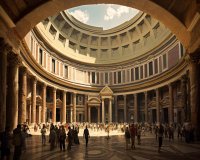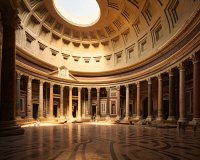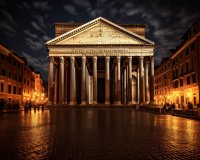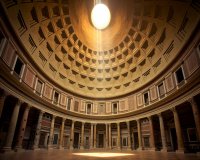The Roman Pantheon: A Marvel of Architecture
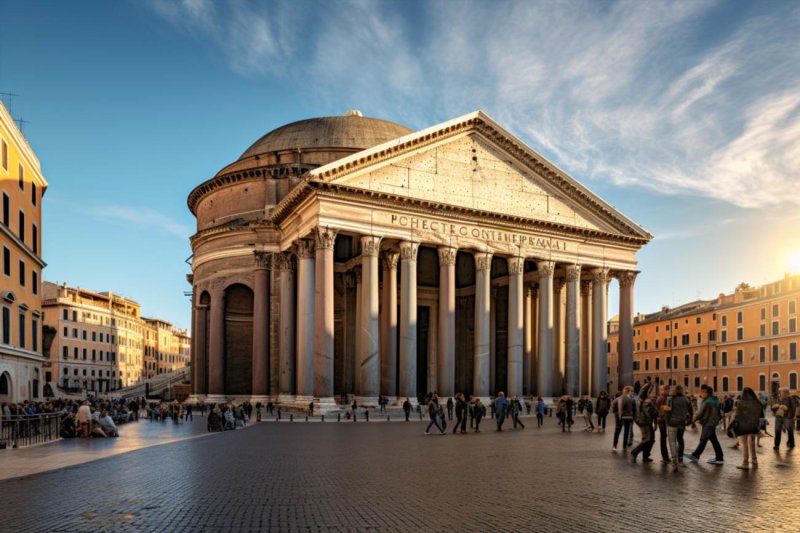
The Pantheon: Rome's Architectural Masterpiece
The Pantheon, located in the heart of Rome, stands as one of the most iconic and well-preserved ancient buildings in the world. This architectural masterpiece is a testament to the ingenuity of the Romans and continues to captivate visitors with its grandeur and historical significance.
Construction of the Pantheon began in 27 BC under the direction of Marcus Agrippa, a close associate of Emperor Augustus. However, the current structure that we see today owes its existence to Emperor Hadrian, who rebuilt it around 126 AD after the original building was destroyed by fire.
The Pantheon's architectural marvel lies in its unique design. The most striking feature is its massive dome, which was the largest dome in the world for over a millennium. Made of concrete and featuring a central oculus (an opening) at the top, the dome serves as both a structural wonder and a source of natural light. This oculus allows sunlight and rain to enter the building, creating an awe-inspiring effect.
As you approach the Pantheon's impressive portico, you are greeted by a row of towering Corinthian columns. These columns, made of granite, add to the building's grand appearance and give it a timeless elegance. The inscription above the entrance, which reads "M·AGRIPPA·L·F·COS·TERTIVM·FECIT" (Marcus Agrippa, son of Lucius, having been consul three times, made it), pays homage to the original builder, Marcus Agrippa.
Stepping inside the Pantheon, you are immediately struck by the vastness of the interior space. The dome, with its 142-foot diameter, creates a feeling of openness and grandeur that is hard to put into words. The remarkable engineering of the dome is a testament to the ancient Romans' architectural prowess. It's worth noting that the Pantheon's dome remained the largest until the construction of the Florence Cathedral dome in the 15th century.
The interior of the Pantheon also houses a number of tombs, including that of the famous Italian painter Raphael. These tombs serve as a reminder of the building's transition from a temple dedicated to all the gods (which is what "Pantheon" means) to a Christian church in the 7th century.
The Pantheon's enduring appeal is not just due to its architectural splendor but also because of its historical and cultural significance. It has inspired countless artists, architects, and thinkers throughout history, leaving an indelible mark on Western art and architecture.
Today, the Pantheon continues to be a place of worship and a popular tourist attraction, drawing visitors from around the globe. Its enduring beauty and historical importance make it a must-visit destination for anyone traveling to Rome.
In conclusion, the Pantheon stands as a testament to the architectural genius of ancient Rome. Its awe-inspiring dome, grand portico, and rich history make it a symbol of Rome's enduring legacy and a must-see landmark for anyone interested in history, art, or architecture.
Rome Pantheon Express Tour: Unveiling Architectural Marvels
Embark on a captivating 60-minute journey through the heart of Rome, delving into the secrets of the Pantheon, a Roman Temple dedicated to all the gods. Led by a knowledgeable guide, explore the intricate architecture and rich history that define this iconic landmark.
Marvel at the miraculously preserved interiors and the awe-inspiring dome that stands as a testament to engineering brilliance. Uncover the legends and myths surrounding the Pantheon, from the significance of its Oculus to the stories behind the eminent tombs within.
Delve into the Archaeoastronomical Story of the Pantheon's Dome, gaining insights into its unique design and historical significance. Learn about the engineering marvels that have allowed this monument to defy the ravages of time and gravity, making it the sole survivor of its size and age.
As part of this small group express tour, witness the distinctive central hole, known as the "oculus," and unravel the history of the Elephant by Bernini, adding layers of intrigue to your Pantheon experience.
Experience Highlights:
- Discover the building secrets of the Pantheon's engineering masterpiece
- Enjoy an intimate small-group tour
- Explore one of the most significant Catholic churches in the world
Immerse yourself in the captivating narratives woven by your guide, providing a deeper understanding of the Pantheon's Dome, interiors, and pavement. This tour promises a fascinating exploration of one of Rome's most impressive historical and architectural treasures.
Meeting Point: Meet your guide by the Fountain in front of the Pantheon entrance, identifiable by a sign with the Doooing Experience logo.
Important Information: Visitors are advised to dress appropriately as the Pantheon is a Church; knees and shoulders should be covered.
Price: From $46.22 per person
Check Availability: Reserve your spot today and pay nothing now. Gift options are also available.
Additional Options:
- Pantheon Official Audio Guide with Fast Track Ticket
- Pantheon Skip-the-Line Entry and Guided Tour
- Pantheon Museum Guided Tour with Skip-the-line Ticket
- Small-Group Pantheon Guided Tour with Entry Ticket
Customer Reviews:
Rated 4.7/5 based on 6 reviews from various traveler types. Explore the unforgettable experiences shared by couples, groups of friends, solo travelers, and families.
The History of the Pantheon in Rome
The Pantheon in Rome, often referred to simply as the Pantheon, is one of the most iconic and well-preserved ancient buildings in the Eternal City. This architectural marvel has a rich history that spans over two thousand years, and its enduring legacy continues to captivate visitors from around the world.
The Pantheon stands as a testament to Roman engineering and architectural excellence. Its history is a fascinating journey through different eras and rulers, each contributing to its unique character and significance. Let's delve into the history of this remarkable structure.
1. Ancient Origins
The Pantheon was originally commissioned by Marcus Agrippa, a close associate of Emperor Augustus, in 27 BC. However, the current building is not Agrippa's creation but a reconstruction by Emperor Hadrian in 126 AD after the original structure was destroyed by fire.
Its name "Pantheon" is derived from the Greek words "pan" (meaning "all") and "theos" (meaning "gods"). This name reflects its original function as a temple dedicated to all the Roman gods.
2. Architectural Marvel
One of the most impressive features of the Pantheon is its dome, which was the largest of its kind in the world for over a millennium. The dome's design is a masterpiece of engineering, with a perfect hemispherical shape that remains an inspiration for architects to this day.
The oculus, a circular opening at the top of the dome, provides not only natural light but also a connection between the temple and the heavens. Rainwater is drained through the slightly sloped floor, adding to the ingenuity of the design.
3. Transformation into a Church
As the Roman Empire transitioned into the Christian era, the Pantheon underwent a significant transformation. In 608 AD, Pope Boniface IV consecrated it as a Christian church, and it became known as "Santa Maria Rotonda." This conversion saved the Pantheon from the fate of many other Roman temples, which were often dismantled for their valuable materials.
Today, the Pantheon is still a functioning Catholic church and is a place of worship and reflection for many.
4. Preservation and Restoration
One of the reasons the Pantheon remains in such good condition is due to its continuous use throughout history. Its well-maintained state can also be attributed to various restoration efforts over the centuries.
In the 17th century, Pope Urban VIII removed bronze beams from the portico to create cannons for the Castel Sant'Angelo. The bronze was then used to create the baldachin inside St. Peter's Basilica. These actions were met with controversy but contributed to the preservation of the Pantheon's structure.
5. Cultural Significance
The Pantheon has been a source of inspiration for countless artists, architects, and writers over the centuries. Its influence can be seen in the design of numerous buildings worldwide, and its iconic dome has left an indelible mark on architectural history.
Visiting the Pantheon allows one to step back in time and experience the grandeur of ancient Rome. The interplay of light and shadow within the building, especially when the sun shines through the oculus, creates a truly awe-inspiring atmosphere.
With its remarkable history and architectural significance, the Pantheon in Rome continues to be a symbol of human achievement and ingenuity, captivating all who have the privilege of walking through its hallowed doors.
In Conclusion
The Pantheon's journey from an ancient Roman temple to a modern-day church is a testament to its enduring legacy. Its architectural brilliance, historical importance, and cultural influence make it a must-visit destination for anyone interested in the fascinating history of Rome and the world.
Rome: Explore the Pantheon Museum with a Guided Tour and Skip-the-line Ticket
Discover the ancient wonders of Rome at the Pantheon Museum with an expert guide. Skip the long lines and delve into the history and architecture of this iconic structure, a well-preserved testament to Roman engineering.
Marvel at the breathtaking dome, a masterpiece of Roman engineering, as your guide unveils the secrets of its construction. Gain insights into the Pantheon's role as a temple dedicated to the gods of Ancient Rome, and appreciate its intricate design up close.
Continue your journey through time as you explore the museum's impressive collection of artwork and artifacts. Admire stunning sculptures, ancient mosaics, and historical objects that narrate the Pantheon's rich and varied history.
A highlight of the tour is the tomb of the renowned painter Raphael, buried in the Pantheon in 1520. Learn about Raphael's life and his significant impact on the Renaissance art movement from your knowledgeable guide.
Throughout the tour, your guide will provide valuable insights into the cultural and historical significance of the Pantheon. Leave the museum with a deeper understanding of this remarkable structure and its place in Roman history.
Save up to 20% when you book this guided tour, including a skip-the-line ticket, to make the most of your visit to the Pantheon Museum. Reserve your spot today and pay nothing until later.
The Architectural Genius of the Pantheon in Rome
The Pantheon in Rome is a masterpiece of ancient architecture, showcasing the unparalleled engineering and artistic skills of the Romans. Built over 2,000 years ago, this iconic structure stands as a testament to the enduring legacy of Roman civilization and its architectural prowess.
Designed by the Roman architect Apollodorus of Damascus, the Pantheon's construction began in 27 BC during the reign of Marcus Agrippa. However, the current building is not the original one, as it was destroyed by fire and subsequently rebuilt by Emperor Hadrian around 120 AD. The Pantheon's enduring appeal lies in its unique and innovative design elements that have captivated architects, scholars, and tourists alike for centuries.
The Dome: A Marvel of Engineering
One of the most striking features of the Pantheon is its massive dome. The dome of the Pantheon is a remarkable architectural achievement and is considered one of the largest unreinforced concrete domes in the world. Its incredible size and shape have puzzled architects and engineers for centuries, as it was a true engineering marvel of its time.
The dome's inner surface is a perfect hemisphere, with a diameter of 43.3 meters (142 feet), creating a sense of awe and wonder for those who enter the building. To this day, the method used to construct such a massive dome without modern technology remains a subject of study and debate among scholars.
The genius of the dome's design lies in its ability to distribute weight evenly, thanks to a series of stepped concrete rings that decrease in thickness as they ascend, culminating in an oculus or circular opening at the top. This oculus not only provides natural light but also symbolizes the connection between the earthly and celestial realms, a concept central to Roman religious and philosophical thought.
The Perfect Proportions
Another remarkable aspect of the Pantheon is its perfect proportions. The building's height is equal to its diameter, creating a harmonious and balanced interior space. The use of geometry and mathematics in its design is a testament to the meticulous planning that went into creating this architectural masterpiece.
Inside the Pantheon, visitors are greeted with a sense of grandeur and symmetry. The floor plan is circular, and the space is filled with natural light streaming through the oculus, casting ever-changing patterns of light and shadow on the walls and floor. This interplay of light and space enhances the sensory experience of the Pantheon, making it an architectural wonder that continues to inspire awe.
The Influence of the Pantheon
The architectural genius of the Pantheon has left an indelible mark on subsequent generations of architects and builders. Its design principles have been emulated in countless structures, including churches, government buildings, and museums. The Pantheon's enduring influence is a testament to the timelessness of its design and its ability to transcend centuries of changing architectural trends.
Throughout history, the Pantheon has been admired, studied, and celebrated for its ingenuity. It has served various purposes over the years, from a temple dedicated to Roman gods to a Christian church dedicated to St. Mary and the Martyrs. Today, it stands as a symbol of Rome's rich architectural heritage and its capacity to inspire wonder and admiration.
Conclusion
The Pantheon in Rome is a masterpiece that defies the passage of time. Its architectural genius, from the awe-inspiring dome to its perfect proportions, continues to captivate and inspire. As one stands within its hallowed walls, it's easy to appreciate the ingenuity of the ancient Romans and the enduring legacy they left behind in the form of this remarkable structure.
Visiting the Pantheon is not just a journey through history but a testament to human creativity and engineering prowess. It is a place where the past meets the present, where architectural innovation and artistic beauty come together in perfect harmony, creating an experience that leaves an indelible mark on all who have the privilege of walking through its ancient doors.




